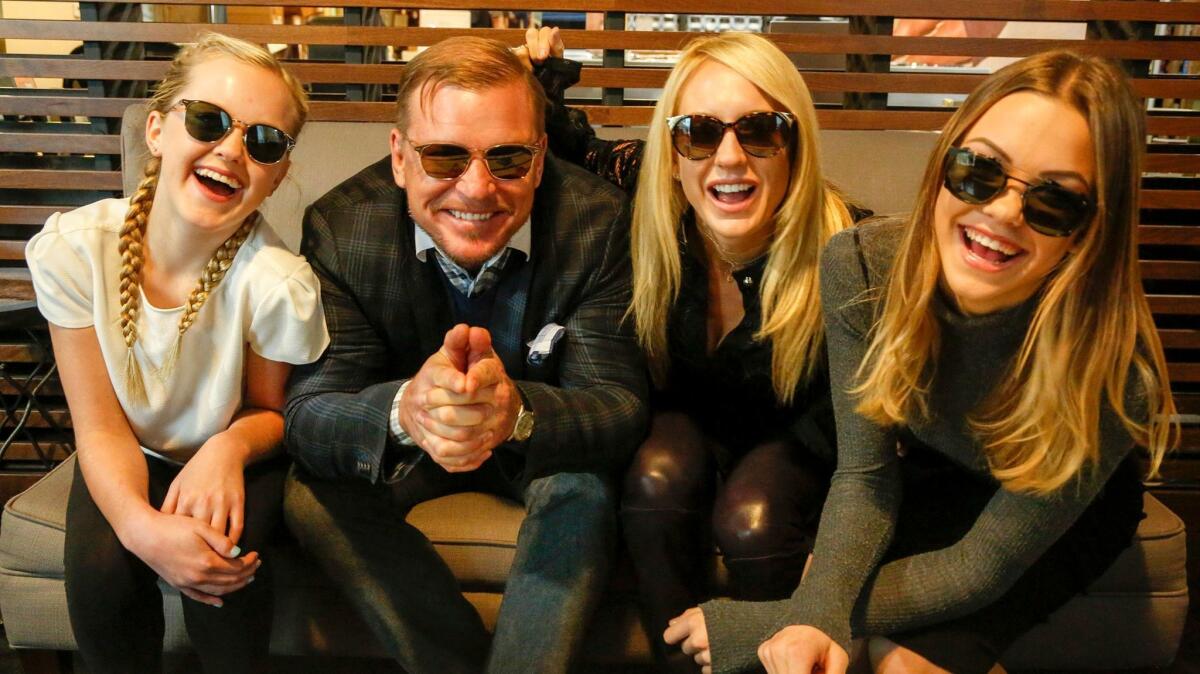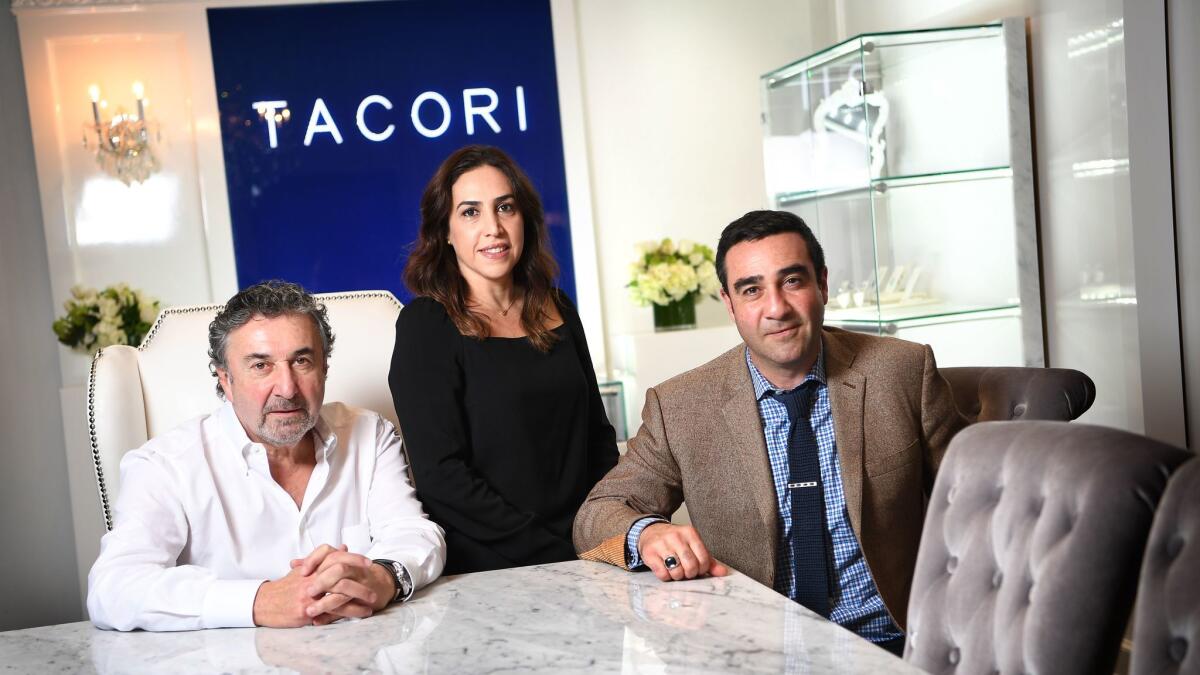Designing L.A.-area fashion brands and labels that stay in the family

Starting any sort of business can be an intimidating prospect. To be in the mercurial fashion trade? Even more so, which might explain why a number of successful Los Angeles-area fashion labels and businesses are run by family members, who conjoin their tastes, share the risk and divvy up the work duties.
“Our business is creative, which means emotional,” said Mitchel Primrose, co-founder with his sister, Carmen, of his eponymous handbag and accessory line. “Having family together lends itself better to expressing and absorbing that emotion because it’s not always easy. [We] are able to help draw out what the other is thinking.”
Along with the Primroses, here’s a look at five other local fashion businesses that are keeping it in the family.

Arcady
Billy Hines and his younger brother, Christopher, agree their shared design outlook was shaped by the refined tastes of their mother.
“Growing up around that was a huge influence on my personal style,” said Billy.
The siblings had a film-financing business before seguing into fashion. Together with friend Jack Hurley, they founded Arcady (www.arcady.com) in Los Angeles late last year. The name comes from a street close to the Hines’ parents’ Santa Barbara home. It’s also a reference to the ancient Greek region of Arcadia, which translates to “rustic paradise.” “The brand embodies that sensibility,” Chris said.
The collection encompasses easy luxury staples such as cashmere hoodies, crisp Mandarin collar shirts and suede vests, mostly in a neutral palette of steel gray, white and black.
“It’s about clean lines, material, construction, and design that’s not fussy but focused on what the essence of the piece is,” Chris said.
The brothers have long been fans of brands such as Brunello Cucinelli and Loro Piana and wanted to create clothing of comparable quality but at a more modest price point. (The Arcady line generally runs from $65 to $2,400.) Chris said the collection is targeted to the 25- to 45-year-old “who can afford the shirts but would need some coin in their pocket for the other pieces.”
“We weren’t finding a good American brand that was classic but not stuck in the past,” said Billy. “That’s the niche that this fills.”
Clear Weather
Brothers Josh and Brandon Brubaker spent a combined three decades at footwear giants such as Converse, Vans and Supra. In 2014, the siblings, who left their corporate careers, joined forces and launched Clear Weather (www.clearweatherbrand.com), a Costa Mesa-based, high-end sports shoe brand that has accumulated a bit of a cult following (for example, one limited-edition style sold out in less than 90 minutes).
What began with three styles has since grown to 32 across categories for men, women and the skateboarders, with prices ranging from $65 to $350.
The brothers say the out-of-the-gate success of the brand — it’s done collaborations with Barneys New York and Bloomingdale’s — has to do with how it reworks classic sneakers.
“It’s hard to get people out of the shoes they’ve been wearing for years,” said Brandon, the older of the two. “It’s about clever, thought-out design that’s still wearable.” Top sellers include the Cloud Stryk, a distinctive cross trainer in suede and neoprene.
The brothers pitch in on all aspects of the business.
“We share the same aesthetic,” said Josh. “We’ve told each other that we are brothers before business partners.”
Athletic Propulsion Labs
Twin brothers Ryan and Adam Goldston were surprised when their limited-edition kicks — fashioned from crocodile skin painted with a double layer of 24-karat gold and priced at $20,000 — found eager buyers.
“We sold a fair number,” said Adam. “Some days, we sold numerous pairs.”
The APL Lusso Supreme made its debut last November in — no surprise — Dubai. But it is not what the Goldston brothers, co-founders of the nearly 9-year old Los Angeles-based Athletic Propulsion Labs (www.athleticpropulsionlabs.com), are most known for. Instead, consumers covet their chic, urban sneakers in quilted leather or blush pink running shoes made from metallic mesh that almost resembles handspun crochet. (Oprah Winfrey wore a pair of APL shoes on the January 2017 cover of O, the Oprah Magazine.) Prices range from $140 to $350 at retailers that include Saks Fifth Avenue, Barneys and Net-a-Porter.com.
“The core principle that we live by is we don’t use big emblazoned logos,” said Ryan. “We let the technology tell the story.”
The brothers, who also sell men’s and women’s athletic apparel, dreamed up APL together in their dorm room as part of a mentorship program and say they are aligned every step of the way.
“We share a lot of everything,” said Adam. “Ryan sees colors perfectly as they are meant to appear, and I’m focused on social media and product technology. The business is based on what our joint vision is.”

Tacori
Paul Tacorian and his sister, Nadine Arzerounian, couldn’t imagine doing anything other than jewelry, given that their grandfather was a jeweler in Romania and their father went into that business after immigrating to California from Armenia in the 1970s.
Today, Tacorian is chief executive of Glendale-based Tacori (www.tacori.com), his sister is COO, and their father, Haig Tacorian, is chairman. Its fashion-centric offerings (pale blue diamonds, stackable rings, collections inspired by a misty day in Sonoma) at a moderate price point are aimed toward stylish millennials.
“Tastes have changed, people have a lot of distractions, and we want to make pieces that are beautiful and fashion-forward,” Paul said. Tacori pieces, which are available at independent boutiques around the Southland, start at around $500 — and while they can stretch to upward of $10,000, a substantial-looking engagement ring can be found for about $4,000.
Arzerounian, who inherited her father’s and grandfather’s jewelry tastes, said that the upcoming Crescent Cove collection is “inspired by the curves of the California coastline.”
“It has movement and is similar to waves crashing on the coast,” she said. “And a lot of inspiration is taken from dentelle lace, which is used in Romania. We take that lacy design and pair it with black diamonds for something very modern.”

Leisure Society
Shane Baum asked himself a simple question before launching his luxury eyewear brand, Leisure Society (www.leisure-society.com).
“When you see a woman on the red carpet wearing a $14,000 gown and $4,000 shoes, why isn’t she wearing sunglasses that are like jewelry? There’s no reason why what she’s wearing around her neck is more important than what’s on her face.”
With the Costa Mesa-based company that he runs with his parents, daughters and fiancée, Baum intends to redress that imbalance. His eyewear, spotted on Jennifer Lawrence and Nick Jonas, is made of 18- to 24-karat gold, priced from $375 to $1,200 and sold through high-end optical stores as well as boutiques including Fred Segal and Bergdorf Goodman. Before becoming a brand owner, Baum designed eyewear for Paul Frank and Louis Vuitton, for whom he also planned curated cultural events, invitations to which would read, “By Order of the Royal and Ancient Leisure Society.”
Baum, who grew up in Iowa in a town of 2,500 people, said running the business with family has been important from the outset: his mother oversees the warehouse, his father pays the bills, his fiancée runs marketing and public relations, and his two daughters come in on weekends to pick colors for new collections.
“Kids are very intuitive, and I trust their opinions,” he said. “They’re switched on as far as trends. They’ll be the ones taking over when I’m gone.”
Mitchel Primrose
The models in the latest Mitchel Primrose campaign had their hair and makeup completed by Carmen Primrose, sister of designer Mitchel Primrose and the brand’s CEO.
“We started the line together in 2012,” said Mitchel. “We overlap constantly. I’m always asking her opinion and approval on design and how things should look.”
The brand (www.mitchelprimrose.com) of men’s and women’s jewelry and accessories has a sexy, edgy sensibility; signature pieces include cuffs in white lizard and gold viper, and skinny black chokers made from the skin of the aquatic karung snake (Ariana Grande is often seen wearing one of the chokers). The duo gravitate toward exotic and rare skins to impart a luxurious gloss to structured bags and clutches. The jewelry, which is priced between $125 and $1,395, and the bags, from $1,495 to $8,000, are available through the company’s website.
“It’s rock ’n’ roll but also very glamorous and tailored,” said Mitchel. “I rely on my sister’s aesthetic so much. We grew up very close and were inspired by the same people. Having the brand backed by a sibling duo helps to set us apart. … It sparks a memorable trigger for people.”
ALSO
Japanese fashion stalwart Beams gets the literary treatment
Move over, yoga pants. How Kit and Ace created clothes for work — and meditation
Tom Ford, Jason Derulo, Isla Fisher, Chris Martin and others gather for An Unforgettable Evening



